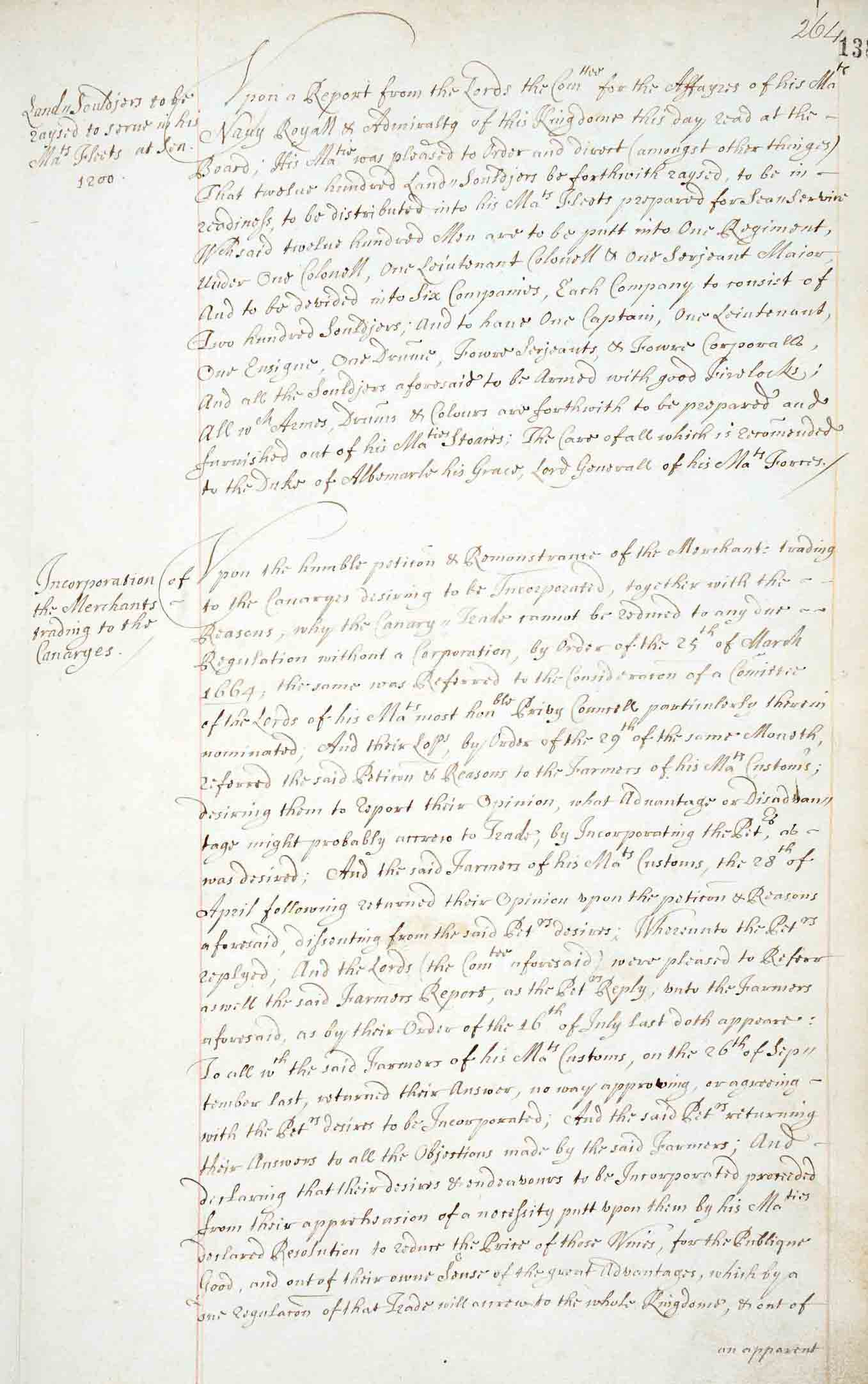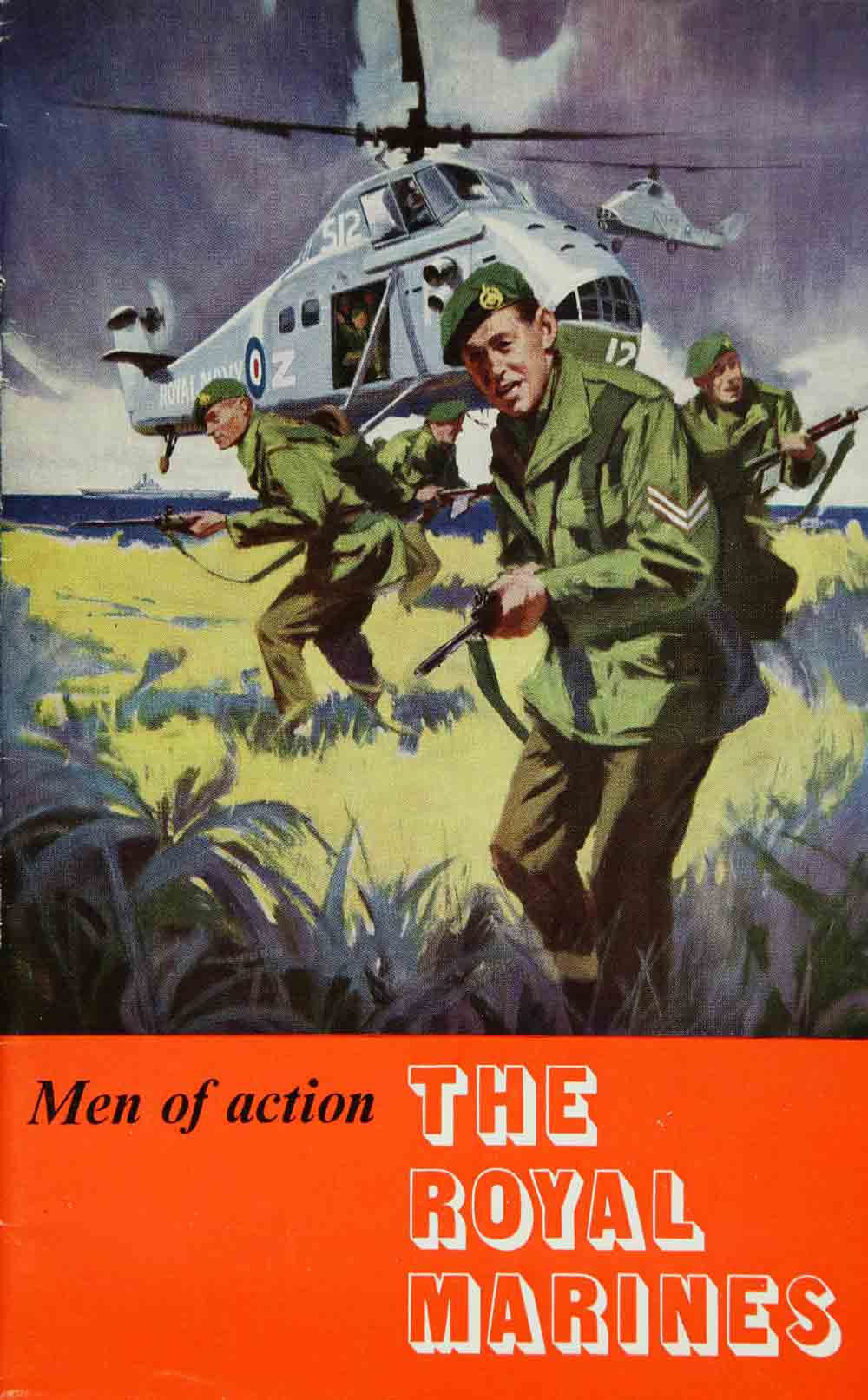Today marks the 350th anniversary of the Royal Marines. It is an achievement that almost wasn’t achieved at all, as they have faced extinction several times in their history. Not least in their troubled infancy.
350 years ago today, at a meeting of King Charles’ II Privy Council, a directive was issued to raise a new Regiment for the Army: the Duke of York and Albany’s Maritime Regiment of Foot (PC 2/57 f138). As James, Duke of York, and later James II, was then also Lord High Admiral the Regiment became known as the Admiral’s Regiment. Originally raised with 1,200 soldiers their purpose was to serve at sea on ‘his Majesty’s Fleets’.

Order in Council for the formation of the Duke of York and Albany’s men. Catalogue reference: PC 2/57 f138
It wasn’t long before the regiment saw action. They fought in three major battles during the second Anglo-Dutch war: the Battle of Lowestoft on 13 June 1665 where the English fleet was commanded by James himself saw the English defeat the Dutch ,but fail to press home the advantage. They also fought in the Four Days’ battle between 11-14 June 1666 where the Dutch turned the tables and in the St James’ Day battle of 4 August 1666 which saw another English victory (all dates new calendar).
When James, Duke of York, became King James II in 1685, George, Prince of Denmark, took over the colonelcy of the regiment and it changed its title to the Prince of Denmark’s Regiment or simply the Prince’s Regiment.
James, meanwhile, set about alienating himself from his subjects over his Roman Catholicism, and by the time William of Orange landed in Torbay in 1688 to lead the Glorious Revolution, James had lost the trust and confidence of the army. Most of the army went over to William’s side, but the Prince’s regiment remained loyal to James. The regiment’s loyalty was its undoing and it was disbanded in 1689.
A year later two Marine regiments were raised for sea service. However, as they were part of the Army but serving the Admiralty they were ill used and often filled in the gaps in ship’s companies. The financial system could not cope with paying Marines distributed across the fleet and the men often went unpaid for long periods of time.

Royal Marines recruitment poster, catalogue reference: INF 13/270 (7)
In June of 1672 the Dutch surprised the English Fleet in harbour at Solebay, in what turned out to be the first battle of the third Anglo-Dutch war. Lord Arlington’s secretary, Captain Taylor wrote ‘those marines of whom I so oft have wrote you, behaved themselves stoutly’. The sea soldiers had become marines.
By the time peace came to Europe in 1697 there were four marine regiments. Unfortunately their fate was tied up with the rest of the army and they were disbanded and joined over 70,000 other soldiers whose services were no longer required.
Peace did not last long and when Carlos II of Spain died without an heir, Louis XIV of France claimed the throne for his grandson, Philip. Archduke Charles, son of the Austrian Emperor also staked his claim. Parliament authorised the raising of fifteen regiments amongst them six marine regiments.
During the war of the Spanish succession, in 1704, Gibraltar was taken by a force of mostly English marines. There was fierce fighting over ‘The Rock’ and the marines in a report on the defence of Gibraltar were said to have ‘gained an immortal honour’. The treaty of Utrecht, signed in 1713, brought an end to the War of the Spanish succession and gave Gibraltar to England in perpetuity.
Peace brought disbandment again and for 26 years there were no marine regiments. Six regiments were raised again for the War of the Austrian Succession, and in 1741 all of them were sent to Jamaica to prepare for action in Cartagena, South America. The journey to Jamaica saw about a quarter of the 9,000 strong force die or become sick, and yellow fever spread through the force. By the end of the expedition only one man in ten survived.
In 1748 the marine regiments came under Admiralty command and in 1755 the decision was taken that the establishment of Marines should be 5,000 and they should be divided into three divisions at Portsmouth, Plymouth and Chatham. The marines as we now recognise them through the records of the next 250 years and more had arrived.
You can help us unpick the story of the next 250 years through a new project being launched today. The records in ADM 158, Royal Marine Description books, cover hundreds of thousands of serving marines from 1760 to 1925. We are digitising these records in a new ‘working from home’ volunteer project. To register your interest in taking part please contact volunteer@nationalarchives.gov.uk.
“In June of 1792 the Dutch surprised the English Fleet in harbour at Solebay…”
That should be 1672.
“In 1847 the marine regiments came under Admiralty command…”
That should be 1748.
The Treaty of Utrecht says that Gibraltar was returned to Britain, not England.
I wish the RM Commandos a HAPPY 350th ANNIVERSARY. I was a naval support officer (Mobilized RMN Volunteer Reserve) under 42 RM Commando – Tawau Assault Group (TAG) in the Borneo front lines from Oct 1964 – May 1965. This was the time of Indonesian Confrontation (1963-1966). The Senior Officer TAG was Major Nigel Martin. It was a fantastic experience to serve with the FOUR-TWO, and go on some of the riverine patrols with them. The greatest honor was that I was awarded the Borneo (GSM) for my service with TAG. I have edited a book Naval Reservists in Action: WW II (FE) and Confrontation (1963-1966) launched in Nov 2013. The book also includes the operations of the Royal Marines during those periods, and I have sent a complimentary book to the RM Library. The Royalties derived from book sales go to RN Naval Charities.
Could anyone out there assist? My Great, Great Grandfather, Edward DRAPER was a Royal Marine, Sergeant, based at East Stonehouse. He married Mary Anne Williams at the parish church at Stoke Damerel, Devon on 22nd August 1850. His attestation papers dated 1840 state he was born in Dalton Lancashire in 1820, son of George Draper, Grocer. I can find no trace of his birth or his father in Lancashire. Would there be any other records held which would enable me to find his forebears?
His son, John Edward Draper, born 11th February 1858, joined the Royal Navy at the age of 15 as a ‘Band Boy’ in the Implacable. He was a musician like his father, and by the age of 22, was listed as Bandmaster of the ship Wolverine. The Wolverine was given to the people of New South Wales, Australia (in 1882 I think) as a ‘Royal Gift’. John Edward Draper had by that time left the Royal Navy after years of service in the ‘Pacific Station’ and joined the Australian Forces. I believe he conducted the first combined Military Band in Australia. I have some lovely photos of this Band.
Any assistance in this area would be so helpful.
Demelza Matthews